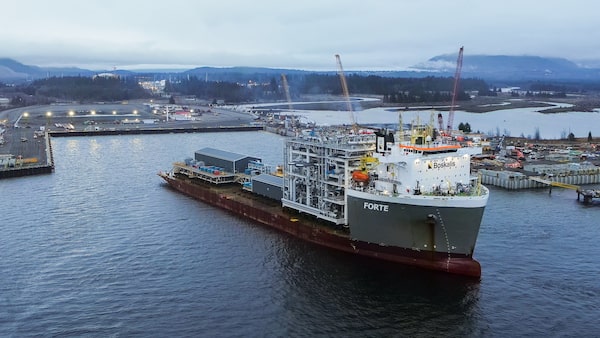
A module arrives aboard a vessel at Kitimat, B.C., on March 10. The module is for installation at LNG Canada’s export terminal in Kitimat.Courtesy of LNG Canada
LNG Canada is gearing up for the peak construction phase at its massive terminal in British Columbia, reiterating its target to start exporting liquefied natural gas to Asia in 2025.
LNG Canada, led by Shell PLC SHEL-N, is the only Canadian project under construction that would export the fuel aboard ocean-bound tankers. In the United States, in sharp contrast, exports of natural gas in liquid form began six years ago and there are now seven major terminals already in operation.
At the peak of construction, from this year through 2024, LNG Canada will require up to 7,500 workers on rotation, with room for 4,500 people at any given time at the on-site accommodation centre in Kitimat, B.C.
Peter Zebedee, chief executive officer of LNG Canada, said the $18-billion terminal is nearly 60 per cent complete and preparing for the busiest phase. “This is a very important year for us, with a pace of construction not seen previously,” he said in a statement.
JGC Fluor BC LNG JV, an engineering joint venture between JGC Corp. and Fluor Corp., is LNG Canada’s prime contractor. Construction of the terminal began in October, 2018, on the Kitimat industrial site that is located on the Haisla Nation’s traditional territory.
The engineering involves both Canadian and global supply chains. Huge modules are being built at China Offshore Oil Engineering Co. Ltd.’s fabrication yard in Qingdao, China. One module more than 10 storeys tall arrived in Kitimat last Thursday.
Smaller modules are being supplied by a fabrication yard in Zhuhai, China, run by a joint venture between Fluor and China National Offshore Oil Corp.
“We remain committed to shipping our first cargo by the middle of this decade,” LNG Canada said in a statement, noting that it is focused on delivering “made-in-B.C. LNG to Asian markets that need it.”
Various equipment will be installed at the Kitimat site, including the 10-storey module that will be connected to the Coastal GasLink pipeline system to be operated by TC Energy Corp.
Last week, TC Energy TRP-T reached option agreements to sell a 10-per-cent stake in the contentious Coastal GasLink pipeline to two groups of elected First Nations along the pipeline route. Coastal GasLink is being built to transport natural gas from northeastern B.C. to Kitimat.
Coastal GasLink has been the target of vocal opposition from a group of Wet’suwet’en Nation hereditary chiefs and their supporters, who say the pipeline project does not have the consent of those hereditary leaders.
Of the 24 Canadian LNG proposals tracked by federal authorities five years ago, 18 were in British Columbia, with all of those focused on exports to Asia. There were three LNG proposals in Nova Scotia, two in Quebec and one in New Brunswick.
Only four proposals for exporting with LNG vessels remain active in British Columbia: Woodfibre LNG, Cedar LNG, Ksi Lisims LNG and expansion plans by a terminal called Tilbury LNG, which is currently focused on production for domestic use and storage.
In the United States, Cheniere Energy Inc.’s Sabine Pass LNG project opened in February, 2016, making its initial shipment to Brazil.
There are now seven major LNG export terminals in the United States, after the Calcasieu Pass project in Louisiana began exporting last month, with its first shipment headed for Asia. Golden Pass LNG in Texas is eyeing a start date in 2024.
LNG Canada’s exports to Asia would indirectly help Europe because that frees up LNG supplies elsewhere in the world to be rerouted to Europe.
After Russia invaded Ukraine nearly three weeks ago, European natural gas prices have been volatile, hitting a record high last week before falling as fears eased about the severity of shortages of the fuel. Russia supplied an estimated 34 per cent of Europe’s total consumption of natural gas in 2020, accounting for 42 per cent of Europe’s overall imports of the fuel, according to industry analysts.
Within Europe, there are constraints on the ability to accept LNG shipments. Germany, for example, doesn’t have any LNG import terminals but plans to build its first two sites as part of broader efforts to reduce reliance on Russian natural gas piped into Europe.
Dating back as far as 2006, ambitious plans to ship LNG to Europe from Newfoundland and Labrador, Quebec, Nova Scotia and New Brunswick have been either outright cancelled or suspended indefinitely.
Last summer, Pieridae Energy Ltd.’s Goldboro LNG venture in Nova Scotia vastly scaled back its plans, switching to a proposed floating facility instead of a large terminal that would have been built on land.
Another proposal, LNG Newfoundland and Labrador Ltd., is in its early planning stages in hopes of starting exports in 2030.
Your time is valuable. Have the Top Business Headlines newsletter conveniently delivered to your inbox in the morning or evening. Sign up today.